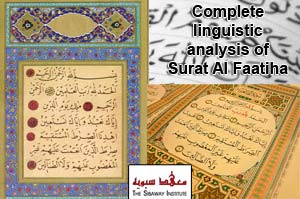FTH: Complete linguistic analysis of Surat Al Faatiha

This course will delve into the linguistics of the Oft repeated verses of Surat Al Faatiha. This is a Surah that we recite many times a day in our prayers but we are unaware of its great meanings that can only be understood through the language of the Quran. We will go through a detailed word by word analysis along with many relevant discussions related to Grammar, Etymology, Morphology and Rhetoric.
Begin to see Surat Al Faatiha in a manner like never before!
Begin to see Surat Al Faatiha in a manner like never before!
COURSE DETAILS
Lesson 1 - Ayah 1: The basmala, the preposition baa and its meanings, The meaning of the word Ism, linguistic details of the name ALLAH, brief discussion on the 2 attributes of mercy
Lesson 2 - Ayah 2: Synonyms for the word Hamd and how they are used in the Quran and Arabic language. The 2 meanings of the definite article associated with Al-Hamd. Brief discussion on the preposition Laam, reconciling between the 2 opinions regarding derivation of the majestic name, Why other sentence structures don't give the same meanings, Alhumdulillah as a informative sentence and a generated sentence.
Lesson 3 - Ayah 2 cont: The use of the Majestic name in the Quran. Word structure of Alhumdulillah and changing word position to create restriction. Restriction used in Surat Al Jathiya. Linguistic analysis of the word Rabb. Linguistic analysis of the word A'lameen.
Lesson 4 - Ayah 3: A deep linguistic analysis of the 2 attributes of mercy, Rahmaan and Raheem. Discussion on Word structures, Quran usage of these attributes.
Lesson 5 - Ayah 4: Linguistic discussion on the word Malik and Maalik. Detailed discussion on the construction Yawm Al Deen. discussion on word choice and sentence structure. The relationship of Ayah 4 to what came before it.
Lesson 6 - Ayah 5:verbal vs normal sentences, restriction, linguistic discussion of na'budu and nasta'een. omission of harf jar and vastness in meaning, discussion on word structure, change from 3rd to 2nd person and meaning associated with this shift.
Lesson 7 - Ayah 6: The verb for guidance used as a direct object and with a preposition. Discussion on structure of sentence. relationship of this ayah to what came before it.
Lesson 8 - Ayah 6 and start of 7 : pattern of the word Siraat, Tareeq and Sabeel and how their meanings are inbuilt into the pattern. Explanation of the word Mustaqeem. A quick grammatical analysis of the Ayah.
Lesson 9 - Ayah 7 : The 2 ways of deviation. The different types of Definiteness. Different words for blessings. Why using other words and other sentence structures is deficient. past vs present tense. [15:00 minutes]
Lesson 10 - Ayah 7 : Word and structure analysis of the 3 groups. Why weren't other structures used? The extra la of negation.
The course is based on a number of classical Arabic Grammar and Balagha texts including: Mughnee Al-labeeb, Sharh Ibn Aqeel, Al Itqan fi ‘ulum al Qur’an by Imam Al Suyooti, Idaah fil 'uloom Al Balgha by Al Qazweeni, Sharh Al mukhtasir A'la Talkhees Al miftaah by Al Taftazani, Tafseer Fath AL qadeer by Imam Showkani, Al Bahrul Muheet by Abu Hayyan, Tafseer Abu Saud, Al Tafseer al Kabeer by Sheikh Fakhar al deen Al Razi, Fathil Qadeer by Sheikh Muhammad Al Shawkani, , Kitaab Sibawayh, Lisan Al arab by Ibn Manthoor as well as the contemporary works of Imam Al-Alusi, Ibn Ashoor and Dr Fadl Salih Alsamaraie.
All necessary Morphological, Grammatical and Balagha ( Rhetoric) discussions will be discussed when necessary.
Lesson 1 - Ayah 1: The basmala, the preposition baa and its meanings, The meaning of the word Ism, linguistic details of the name ALLAH, brief discussion on the 2 attributes of mercy
- Difference between Barakah and N'ima ( 2 words used for blessings)
- Linguistic analysis of the Majestic name
Lesson 2 - Ayah 2: Synonyms for the word Hamd and how they are used in the Quran and Arabic language. The 2 meanings of the definite article associated with Al-Hamd. Brief discussion on the preposition Laam, reconciling between the 2 opinions regarding derivation of the majestic name, Why other sentence structures don't give the same meanings, Alhumdulillah as a informative sentence and a generated sentence.
- Difference between Hamd, Shukr, Thanna, Mahd
- Linguistic discussions with examples from the Quran
Lesson 3 - Ayah 2 cont: The use of the Majestic name in the Quran. Word structure of Alhumdulillah and changing word position to create restriction. Restriction used in Surat Al Jathiya. Linguistic analysis of the word Rabb. Linguistic analysis of the word A'lameen.
Lesson 4 - Ayah 3: A deep linguistic analysis of the 2 attributes of mercy, Rahmaan and Raheem. Discussion on Word structures, Quran usage of these attributes.
Lesson 5 - Ayah 4: Linguistic discussion on the word Malik and Maalik. Detailed discussion on the construction Yawm Al Deen. discussion on word choice and sentence structure. The relationship of Ayah 4 to what came before it.
Lesson 6 - Ayah 5:verbal vs normal sentences, restriction, linguistic discussion of na'budu and nasta'een. omission of harf jar and vastness in meaning, discussion on word structure, change from 3rd to 2nd person and meaning associated with this shift.
Lesson 7 - Ayah 6: The verb for guidance used as a direct object and with a preposition. Discussion on structure of sentence. relationship of this ayah to what came before it.
Lesson 8 - Ayah 6 and start of 7 : pattern of the word Siraat, Tareeq and Sabeel and how their meanings are inbuilt into the pattern. Explanation of the word Mustaqeem. A quick grammatical analysis of the Ayah.
Lesson 9 - Ayah 7 : The 2 ways of deviation. The different types of Definiteness. Different words for blessings. Why using other words and other sentence structures is deficient. past vs present tense. [15:00 minutes]
Lesson 10 - Ayah 7 : Word and structure analysis of the 3 groups. Why weren't other structures used? The extra la of negation.
The course is based on a number of classical Arabic Grammar and Balagha texts including: Mughnee Al-labeeb, Sharh Ibn Aqeel, Al Itqan fi ‘ulum al Qur’an by Imam Al Suyooti, Idaah fil 'uloom Al Balgha by Al Qazweeni, Sharh Al mukhtasir A'la Talkhees Al miftaah by Al Taftazani, Tafseer Fath AL qadeer by Imam Showkani, Al Bahrul Muheet by Abu Hayyan, Tafseer Abu Saud, Al Tafseer al Kabeer by Sheikh Fakhar al deen Al Razi, Fathil Qadeer by Sheikh Muhammad Al Shawkani, , Kitaab Sibawayh, Lisan Al arab by Ibn Manthoor as well as the contemporary works of Imam Al-Alusi, Ibn Ashoor and Dr Fadl Salih Alsamaraie.
All necessary Morphological, Grammatical and Balagha ( Rhetoric) discussions will be discussed when necessary.


